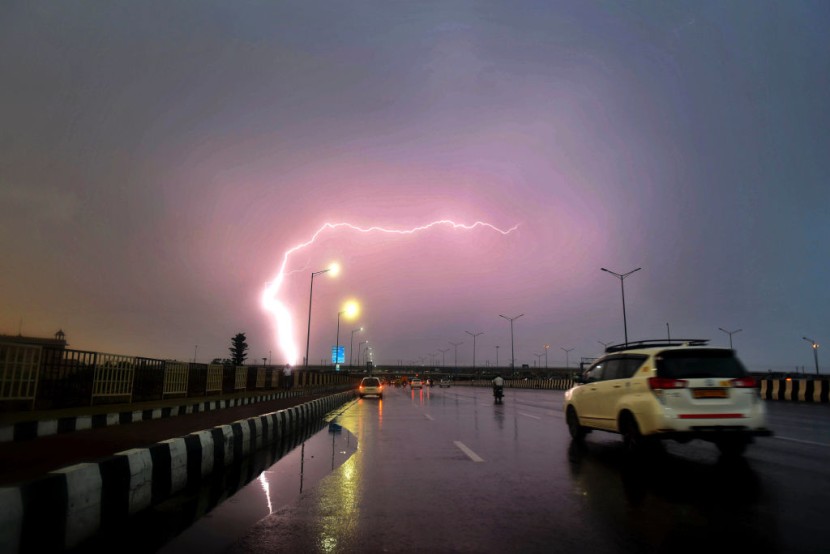
Officials claim that lightning killed at least 38 people in two Indian states in one day. According to authorities, the bulk of the deaths happened in Rajasthan's western state, where 11 individuals died after being struck by lightning near a watchtower at the 12th century Amber Fort.
When lightning hit late Sunday, several of the victims were snapping photos near the watchtower, senior police officer Anand Srivastava said. At least nine additional individuals were killed and almost 20 others were injured in separate lightning strikes during the state's monsoon rains.
India expects more lightning in the following days
Manoj Dixit, a government official in Uttar Pradesh, said that 18 persons were killed by lightning on Sunday. The majority of those fatalities were farmworkers in the fields. The relatives of the victims and those who were injured have received financial compensation from both state governments.
More lightning is expected in the following two days, according to the Indian Meteorological Department. During India's monsoon season, which spans from June to September, lightning strikes are prevalent, Khaleej Times reported.
More than 2900 people were killed by lightning in India in 2019, according to the most recent official figures available. Taking cognizance of the incidents, Chief Minister Yogi Adityanath expressed his grief and directed the district administrations to provide adequate compensation to the tragedy-struck families.
According to the most recent official data available, more than 2900 persons were killed by lightning in India in 2019. After learning of the occurrences, Chief Minister Yogi Adityanath expressed his condolences and instructed the district administrations to offer sufficient compensation to the families who had been affected by the tragedy.
The chief minister had already conveyed his heartfelt sympathies to the families of those killed by lightning in the districts of Kota, Dholpur, Jhalawar, Jaipur, and Baran. After lightning hit the Amer Fort area, 29 persons were saved, as per Jaipur Police Commissioner Anand Srivastava.
Lightning strikes accounted for more than a third of all deaths attributable to the forces of nature in India in 2019, according to the Accidental Deaths and Suicides in India 2019 report. In reality, the report showed that the number of deaths caused by lightning increased in 2018.
A bolt of lightning, often known as a "giant spark of electricity," may pack between 100 million and 1 billion volts of energy and contains billions of watts. Not only that, a lightning strike may also heat the air around it to temperatures ranging from 10,000 to 30,000 degrees Celsius. Simply say, a lightning strike has the potential to be extremely destructive, as per First Post.
Why is lightning a major killer in India?
Often, those who have sought refuge behind trees are the ones who are struck by lightning. The side flash, which occurs when lightning strikes a taller item near the victim and a portion of the current jumps from the taller object to the victim, is the phenomenon at work here.
Per News18, when the victim is within a foot or two of the object struck by lightning, side flashes are common. In India's first Annual Lightning Report (2019-2020), it was discovered that standing under a tree was 71% of all lightning deaths, while direct hits accounted for 25% of deaths, and indirect exposure accounted for 4%.
"Most indoor lightning casualties and some outdoor lightning casualties are attributable to conduction," said the US National Weather Service (NWS). There's also a less-common way for lightning to strike humans known as "streamers," which form as the downward-moving strike approaches the ground.
According to the Annual Lightning Report 2019-2020, which included data from the Indian Meteorological Department (IMD), the highest number of injuries were reported between July 25 and July 31, 2019, with over 4 lakh (400,000) lightning strikes across India. The north-eastern states, as well as the Chota Nagpur Plateau region, were lightning hotspots, the report noted.
When lightning strikes, the NWS advises that there are no safe places to seek shelter outside and that staying indoors is the greatest protection. When people hear thunder, they should go inside since they are within striking distance of the lightning.
IMD has established a lightning prediction system in India, and the weather office issues color-coded warnings for lightning strikes. There is also a daily lightning prediction, as well as "nowcasts" for three-hour intervals on days when there is a lot of lightning.
Related Article: Watch Horrifying Video of Japan Landslide; Rescue Mission Continues With 3 Dead, 113 Missing
@YouTube
© 2025 HNGN, All rights reserved. Do not reproduce without permission.








